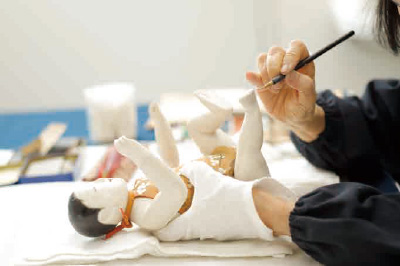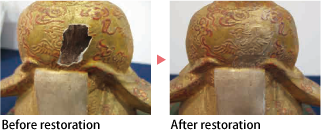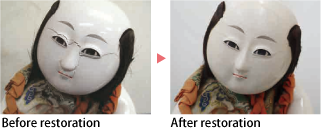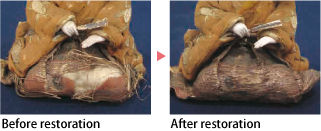Restoration Work at the Saitama City Iwatsuki Ningyo Museum
Restoration Work at the Saitama City Iwatsuki Ningyo Museum
Most of the works in our collection date from the Edo to the early Showa periods, and many, having been kept in less than ideal environments, have aged over the years. Ningyo created using traditional techniques are made of a variety of materials and are thus quite delicate and susceptible to damage resulting from the environment in which they are stored. To be able to hand down our collection to later generations, the museum has thus been steadily working, since 2009, on restoration by specialists in restoring cultural assets.
The principle behind our restoration work is to alter the information in the original work as little as possible. The work is carried out as needed, depending on the condition of the damaged areas and the materials used.

Restoration work in process
The restoration process
- Inspect and examine the state of the artifact and draw up an examination card.
- The curator and restoration specialist discuss the artifact and decide on a restoration plan and method.
- The restoration specialist implements that plan.
As time passes, the artifact may continue to deteriorate for many reasons; it thus may need restoration more than once. Recording the reason for the restoration, the materials used, and other details about the process provides valuable information for further restorations.
Important Points
- Make the artifact able to be handled safely (able to be displayed in exhibitions).
- Alter the original information as little as possible.
- Consider how the restoration works with the artifact as a while and the artifact’s structural stability.
- Make a photographic record of the damage before restoration, the work in process, and the artifact after restoration.
- Include when the treatment was applied, by whom, and how (techniques and materials) in then restoration report.
An example of a restoration method

Ko-Yoshino-bina, male hina (detail)
■Gofun layer peeling:Peeling of the gofun layer is visible on the back. The piece that peeled off was not lost. Dilute acrylic resin was applied to that piece, to strengthen it, and it was glued back in place using shofu nori, a traditional wheat glue. A material to prevent peeling was applied to colored areas that were peeling.

Gosho ningyo A Cockfight (detail)
■Hair loss:Hair disintegrates over time and then falls out every time it is moved. If hair has accumulated in concave areas or the neck opening, for example, clean it out with a brush.
■Cracks in the gofun layer:Dilute acrylic resin is applied to the cracked area. That step is carried out repeatedly to reinforce the undercoat. Depending on the extent of the damage, concentrated acrylic resin may be applied to fill in gaps and bumps. After removing any excess resin, gofun is applied, to restore the surface.

Isho ningyo First Appearance at Court (detail)
■Deterioration of textiles:Over time, the warp yarns were lost and the weft yarns shifted. Washi paper was dyed a color similar to that of the fabric for use as an under layer and shofu nori glue used to hold the weft yarns in place. The type and thickness of the washi paper used varies depending on the type of fabric and how much it has deteriorated.

